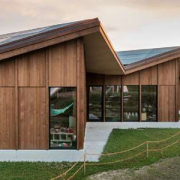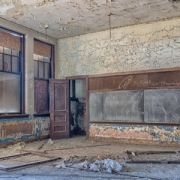The Health and Cost Benefits of Flicker-Free Lighting
By John Davenport
Several years ago, the Nordonia Hills City School District near Cleveland, Ohio, was looking to implement an energy conservation program. When one of the district’s schools, Rushwood Elementary School, began to study the available options, its administrators considered a number of factors—including the fact that the fluorescent lighting long in use had proven disruptive to some of their special-needs students. The decision was made to install flicker-free LED lighting, which could be easily retrofitted into Rushwood’s existing light fixtures. Following the retrofit, differences were noticed immediately across the school: teachers described the LED light quality as crisper, clearer and brighter, with words on paper easier to read; one teacher reported getting fewer headaches; a special-needs teacher noted a more “mellow feel” in her classroom; and the district reduced its total electric bill by about 11 percent.
Rushwood is just one of an increasing number of success stories across the educational landscape involving the installation of flicker-free LED lighting—an innovation with a wide range of advantages over the traditional fluorescent lights that have illuminated educational institutions for decades. For decision makers involved in the construction and renovation of primary and secondary schools as well as colleges and universities, this option represents a key opportunity. Evidence exists that the flicker and spiky spectrum of traditional fluorescent lighting and early-generation LEDs can be detrimental to the health of those in classrooms and other school facilities, whereas flicker-free, full-spectrum LEDs offer a superior option, all while significantly slashing maintenance costs. Not only can the retrofit be performed without hassle; LED bulbs have an extremely long lifetime, which translates into sharply reduced maintenance costs.
Error, group does not exist! Check your syntax! (ID: 2)
Flicker-free LED lighting offers numerous health and cognitive benefits
What are some of the potential health benefits of flicker-free LED lighting? Pioneering controlled studies conducted by Arnold Wilkins of the University of Essex found the occurrence of headaches in office workers who sat beneath fluorescent lighting all day could be reduced by as much as half following a significant reduction in flicker. In addition to dizziness, migraines, eyestrain and fatigue, it has also been shown that seizures can be triggered by the flicker of traditional fluorescent lighting in individuals with photosensitive epilepsy. And while fluorescent bulbs contain mercury—a material that can present a serious safety risk for students if it comes in contact with lungs or skin—LED bulbs do not. Further, in the long term, the ultraviolet (UV) light generated by fluorescent bulbs can contribute to cataract formation and even macular degeneration, with young students especially at risk from the hazards of UV light. All these drawbacks can be avoided through the use of flicker-free LED lighting.
Along with these benefits, flicker-free LED lighting holds the potential to boost the quality of classroom learning and productivity. This is a natural consequence of the fact that students can concentrate more intently—and for longer periods of time—under this type of illumination. The full spectrum and constant irradiance generated by flicker-free LED lighting contribute to greater illumination and sharper color contrast, which in turn can enhance the quality of learning. Such improvements in learning and behavior may be most striking in the population of students with autism, due to their visual hypersensitivity, as well as those with other learning disabilities, as shown, for example in studies by Alexandria Kappel at Indiana University of Pennsylvania. The full-spectrum light from LED (but not fluorescent) lighting, which matches that from the sun, can also promote a healthier sleep-wake cycle in students.
Nor do the advantages of flicker-free LED lighting end at the classroom door; they can also improve the quality of the student experience in gymnasiums and shop classes. For example, under fluorescent lights with a high flicker rate, a basketball thrown across a gym can display a distracting, near-stroboscopic effect. And for those using lathes in metalworking and woodworking classes, the decreased visibility that results from the flicker of fluorescent lighting can pose a safety risk that can be avoided with flicker-free LED lighting.
Significant cost benefits can result from flicker-free LED lighting
In conjunction with these advantages, flicker-free LED lighting can offer significant maintenance cost savings and ease of installation. Converting from fluorescent lighting to LED lighting is increasingly being recognized as a key contributor to environmental sustainability. It is estimated that there are 12 billion fluorescent sockets worldwide; retrofitting all of them with LED lights has the potential to reduce electricity consumption by 960 billion kilowatt-hours globally, the equivalent of removing 679 million tons of CO2 per year. Various school districts have reported savings in the millions of dollars as a result of retrofitting their fixtures with flicker-free LED lighting. Manufacturers of flicker-free LED lighting provide retrofit kits that can be utilized either by school maintenance staff or by third parties.
In addition, the emergence of building Internet-of-Things (“IoT”), leveraged upon rapidly evolving software, electronics, sensor and cloud technologies, will enable LED lighting systems to serve as the hub of connectivity to manage and control IoT devices across school buildings and campuses, thereby substantially optimizing building energy efficiency, improving building performances and elevating the student and faculty experience.
To date, the health and economic advantages of retrofitting with flicker-free LED lighting have been recognized and implemented by more than 230 leading educational institutions, ranging from the University of Minnesota and Yale University to Penn State University and Ohio State University, as well as numerous school districts across the country.
Considering the array of health, learning and economic benefits it offers, flicker-free LED lighting represents a bold advance that is well worth assessing by all stakeholders in the area of school construction, renovation and retrofit.
John Davenport is Chief Scientist at Energy Focus, Inc., an industry-leading innovator of energy-efficient LED lighting technologies and solutions.
Source: School Construction News












 More than £167,000 was spent on advice on improvements at Uphall Primary School.
More than £167,000 was spent on advice on improvements at Uphall Primary School.